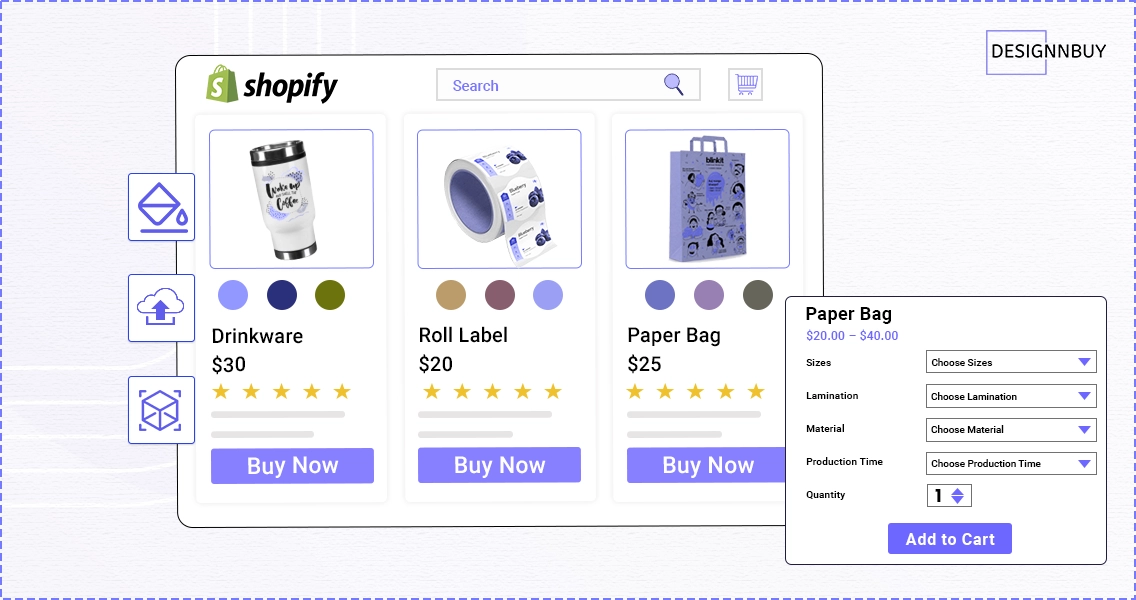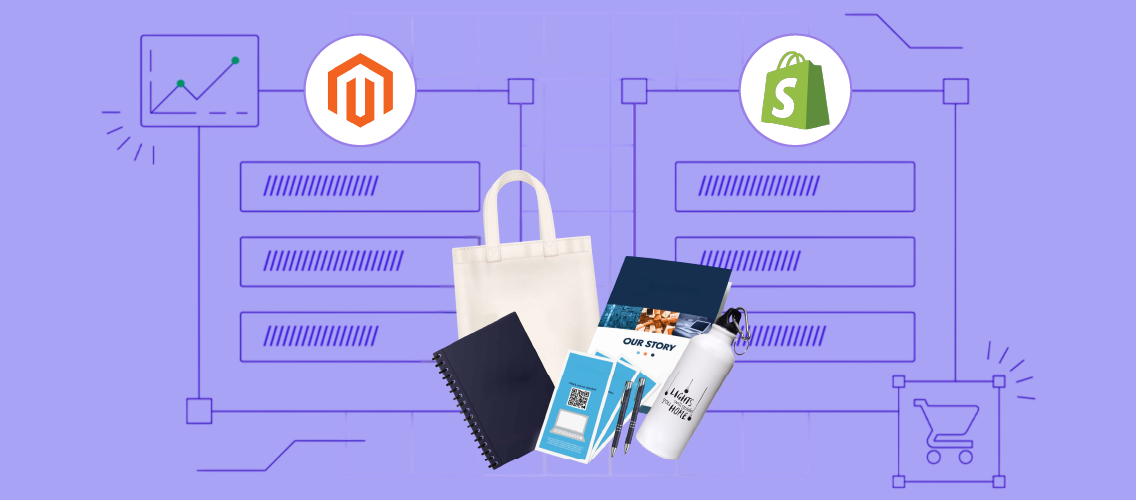When it comes to running a print and packaging business online, one of the most common questions is Magento vs Shopify: which platform works best?
Imagine this: a client visits your site for custom packaging. They want to upload a logo, pick eco-friendly materials, adjust the box size, and preview the design before ordering.
If your web-to-print storefront can’t deliver that smooth experience, they’ll click away, and the order (maybe worth thousands) is gone.
With the web-to-print market growing at 7.5% CAGR and 70% of B2B buyers preferring digital self-service, this is now the standard for print and packaging businesses in 2025. Customers expect Amazon-like convenience with personalized printing options.
If you’re comparing Magento vs Shopify for your print and packaging business, the choice can feel overwhelming. Both platforms are powerful, but the right one depends on your growth stage and needs.
In this article, we’ll break down both, so you can see which platform fits your growth goals.
Table of Contents
Magento (Adobe Commerce) for Print & Packaging
Magento is often described as a blank canvas for e-commerce, and in the print & packaging world, that analogy holds true.
Unlike closed platforms that force you to work within predefined templates, Magento (both the free Open Source edition and the enterprise-level Adobe Commerce Cloud) allows you to design, customize, and automate every step of your customer journey.
For packaging manufacturers, print houses, and B2B suppliers, this flexibility is invaluable. You’re not just selling “products” but you’re selling highly variable, custom-built solutions that often require complex product configurators, detailed quote systems, and integrations with print production workflows.
This is why, in the Magento vs Shopify debate, Magento often comes out ahead for businesses that prioritize deep customization, advanced B2B features, and scalable operations.
The trade-off is higher upfront investment, technical expertise, and ongoing management, but for companies where customization and scalability are non-negotiable, it’s often the superior choice.
Let’s explore its key strengths for print & packaging in detail.
Product Customization

One of the biggest challenges in running a print & packaging store is allowing customers to personalize their orders online. This may include:
- Uploading logos and artwork.
- Choosing dimensions, paper stock, thickness, lamination, or finishes.
- Requesting eco-friendly alternatives (kraft, recycled board).
- Viewing a live preview of how their design will look on the final box or label.
Magento’s open architecture makes it possible to build or integrate sophisticated Magento product configurators. For example:
- Dynamic Pricing Calculators: Automatically adjust pricing when a customer selects premium finishes (e.g., “If glossy lamination is chosen, add $0.15 per unit”).
- 3D Box Rendering: Customers can rotate and preview their design on a box in real-time. This reduces back-and-forth proofing requests.
- Conditional Logic: Different options can appear/disappear based on customer selections. For instance, if the customer chooses “rigid box,” then “magnetic closure” becomes an available add-on.
You can either:
- Integrate existing solutions like DesignO with Magento Integration (which already specialize in print customization).
- Or build a custom module that matches your unique print workflows.
This level of flexibility makes Magento ideal for print resellers that want to provide a bespoke shopping experience rather than forcing customers into generic templates, a key point in the Magento vs Shopify comparison for print and packaging businesses.
SKU & Variant Management
A packaging catalog isn’t like a clothing store where each t-shirt has three sizes and five colors. In print & packaging, a single product, say, a corrugated shipping box, can have hundreds of variations based on:
- Size (length, width, depth).
- Board grade (E-flute, B-flute, etc.).
- Finish (matte, gloss, UV coating).
- Quantity (from 50 to 50,000 units).
Most platforms struggle with “SKU explosion,” but Magento was built to handle complex catalogs with thousands of product variants.
Key capabilities include:
- Configurable products: Link multiple variants under a single product page, so customers can choose options without being overwhelmed.
- Bundled products: Offer packaging + inserts + labels as a combined order.
- Tiered pricing: Natively supported. For example:
- 100 units: $2.50 each
- 1,000 units: $1.80 each
- 10,000 units: $1.20 each
For B2B print suppliers, this volume-based pricing is essential. In the Magento vs Shopify comparison, Shopify requires third-party apps to achieve it, while Magento includes it out of the box.
File Uploads & Proofing
Unlike most e-commerce industries, print businesses rely on customer-submitted files. These are often large, complex design files in formats like PDF, AI, or PSD. Managing these files properly is critical to avoid production delays and quality issues.
With Magento, you can:
- Accept large file uploads (up to 2GB, depending on server configuration). This is crucial for high-resolution packaging artwork.
- Integrate pre-press automation tools that check:
- Bleed and trim lines.
- Color mode (CMYK vs RGB).
- Resolution requirements.
- Store files securely on your own server or cloud storage of choice (e.g., AWS, Azure).
Typical workflow in Magento:
- Customer uploads artwork at checkout.
- System validates file (correct size, format, etc.).
- Automated proof is generated and sent to customer for approval.
- Only approved files move to production.
This reduces costly reprints and eliminates manual back-and-forth emails.
B2B Capabilities
A large portion of the packaging industry is B2B-focused. Corporate clients, agencies, and distributors don’t shop like individual consumers. They expect account-based purchasing, custom pricing, and bulk order support.
Magento shines here with native B2B features:
- Corporate Accounts: Multiple buyers under a single company account, each with assigned roles and permissions.
- Custom Catalogs & Pricing: Offer tailored product ranges and negotiated prices for different clients.
- Request-for-Quote (RFQ) System: Allow buyers to request quotes for large or custom orders, negotiate pricing, and approve online.
- Purchase Orders & Credit Limits: Support for corporate payment methods beyond credit cards.
For example: A design agency ordering 10,000 custom-printed cartons each month can log into their dedicated portal, see their negotiated rates, upload new artwork, and re-order with one click.
This kind of enterprise-grade B2B commerce is where Magento vs Shopify shows a clear difference, Magento is far stronger for complex print and packaging needs.
Hosting & Performance
Magento doesn’t host your store, it’s self-hosted (unless you choose Adobe Commerce Cloud). This means:
- Unlimited scalability: You decide the hosting environment. From a basic VPS to a global cloud infrastructure, you can scale to handle thousands of orders daily.
- Performance tuning: You can optimize caching, use CDNs, or fine-tune databases for speed.
- Security control: Since you own the hosting, you control how customer files and data are stored.
However, this also means:
- You’re responsible for uptime, patches, and security monitoring.
- You need either an in-house IT team or a Magento development partner.
For a print house processing high-value corporate orders, this control is an advantage. But for a startup without technical support, it can feel overwhelming.
Who Magento Fits Best
Magento is not for everyone but it’s a perfect match for certain types of print & packaging businesses:
- Established B2B Print Houses: Those selling to agencies, wholesalers, or corporations that require account-based ordering.
- Businesses with Complex File Workflows: Where artwork uploads, proof approvals, and automated pre-press checks are business-critical.
- ERP-Integrated Packaging Manufacturers: Enterprises that need their online store to sync with inventory, production, and logistics systems.
- Companies With Dedicated IT Resources: Teams that can manage hosting, security, and custom development.
If your business is startup-sized, budget-conscious, and wants to launch quickly, Magento may be overkill. But if your future relies on custom workflows, enterprise B2B sales, and scaling beyond simple online ordering, Magento is the more future-proof option.
Shopify for Print & Packaging
If Magento is the “blank canvas,” Shopify is the plug-and-play powerhouse. It’s a fully hosted SaaS platform, meaning everything from hosting to SSL certificates to software updates is managed for you.
For many print and packaging entrepreneurs, this makes Shopify a very attractive choice, especially if you don’t have an in-house development team or the budget for custom enterprise builds.
Shopify excels at speed of setup, ease of use, and scalability. You can go from idea to live store in a matter of days.
However, because it’s a closed platform, customization is limited to what’s possible through apps and APIs. This works well for many small- to medium-sized print shops, but can feel restrictive for enterprise players with complex workflows.
Let’s break down Shopify’s strengths and trade-offs for print & packaging in detail.
Product Customization

One of the most important features for print & packaging stores is the ability to offer interactive customization. Customers rarely buy “off the shelf” they want boxes, bags, or labels personalized with their logos, artwork, or specific dimensions.
Shopify’s strength here lies in its massive app ecosystem. Solutions like DesignO – The best Shopify Product Designer can be useful to:
- Let customers upload their own designs.
- Provide real-time previews (e.g., see their logo on a mockup of a shipping box).
- Handle dynamic pricing (e.g., higher costs for metallic foil stamping or spot UV coating).
- Support approval workflows where customers sign off on designs before production begins.
For small to large print shops, this “apps-first” approach is a game-changer. You don’t need to build custom configurators from scratch; you can launch with an app in a few hours, using Shopify-supported configurators.
Limitation: Highly specialized needs like automated pre-press checks (detecting low resolution, wrong color mode, missing bleed) are harder to implement in Shopify. You’ll often need custom development or external pre-press software to fill this gap.
SKU & Variant Management
Packaging products come with a dizzying number of options: size, board grade, finish, lamination, and order quantity. Managing these combinations is tricky.
Shopify’s native limit is 100 variants per product, which is fine for simpler catalogs but restrictive for print suppliers with hundreds of combinations. For example, a custom mailer box with 10 sizes × 5 colors × 3 finishes = 150 variants, Shopify won’t handle that without apps.
To overcome this, many packaging businesses use solutions like, Web to pack to easily manage their packaging business.
- Infinite Options (create unlimited custom fields)
- Bold Product Options (manage complex product logic).
File Uploads & Proofing
In print, customers need to upload large design files, often in formats like PDF, AI, or EPS. Shopify supports file uploads, but with limitations:
- File size caps (usually around 20–100 MB depending on your plan and setup). Larger files require third-party apps or cloud integrations (Google Drive, Dropbox).
- Many apps like Uploadery or Inkybay let customers attach files during the order process.
- Proofing workflows are usually app-driven: tools like Zakeke generate digital previews, or you can send manual proofs via email.
Challenge for print houses: If you need customers to upload gigabyte-sized artwork files for large packaging jobs, Shopify can become restrictive compared to Magento, where you control the server.
Still, for many small to mid-size print shops handling simpler orders (like business cards, flyers, or small packaging runs), Shopify’s file handling is adequate.
B2B Capabilities
While Shopify is historically a B2C platform, its Shopify Plus plan brings useful features for packaging suppliers catering to wholesale or agency clients.
Key features include:
- Custom Pricing Lists: Offer negotiated rates to specific buyers.
- Wholesale Portals: Create password-protected areas for bulk buyers.
- Automated Workflows (Shopify Flow): Set up rules like “If a B2B customer orders 10,000 units, notify production manager automatically.”
- Multi-location inventory management: Useful if you store stock across different warehouses.
However, compared to Magento’s native B2B suite, Shopify’s wholesale tools are less robust. For instance, Magento allows detailed RFQs and account hierarchies, whereas Shopify usually needs apps or manual workarounds for the same level of depth.
Good fit: Packaging suppliers who serve both direct-to-consumer and smaller wholesale clients but not enterprise accounts needing advanced ERP integrations.
Hosting & Performance
One of Shopify’s biggest advantages is that everything is hosted and managed for you.
- Shopify provides 99.9% uptime, built-in SSL, CDN, and fast page speeds.
- You never need to worry about patches, upgrades, or server optimization; Shopify handles it all.
- Security (PCI compliance, DDoS protection) is included out of the box.
For busy entrepreneurs, this is a huge relief. You can focus on sales, not server logs.
Limitation: Because it’s fully hosted, you cannot control the server environment. This means no custom server-side integrations (e.g., connecting directly to a printing press workflow tool). Any deep integration must go through Shopify’s API or middleware solutions like Zapier.
Who Shopify Fits Best
Shopify is best suited for:
- Startups & Small Print Shops: Those who want to launch quickly with minimal IT overhead.
- Design-Focused Entrepreneurs: Businesses that focus more on branding and customer acquisition than backend complexity.
- Hybrid B2C/B2B Stores: Shops selling directly to consumers but also offering wholesale packs to agencies.
- Agile Teams: Companies that want to test new ideas, launch seasonal product lines, or pivot quickly without heavy development.
If your business needs rapid growth, ease of management, and marketing flexibility, Shopify is a great fit. If you require deep customization, heavy B2B workflows, or large file handling, you may outgrow it as you scale.
Magento vs Shopify: Head-to-Head Comparison (2025)
| Feature | Shopify | Magento (Adobe Commerce) |
|---|---|---|
| Ease of Setup | Very easy, no coding | Complex, developer required |
| Customization | Limited, app-dependent | Unlimited, fully flexible |
| B2B Features | Only on Shopify Plus | Built-in, enterprise-grade |
| Product Personalization | App-based | Fully customizable |
| Scalability | Best for SMBs | Best for enterprise |
| Time to Launch | Weeks | Months |
| Best For | Small to mid-sized print shops | Medium to large manufacturers |
Why the Right Ecommerce Platform Matters for Print & Packaging Businesses
Unlike selling print on demand products online , print and packaging companies face unique eCommerce challenges:
- Complex Pricing Models: Pricing depends on materials, dimensions, finishes, and order volume.
- Customization Requirements: Customers need tools to upload artwork, design templates, or visualize 3D previews.
- B2B Workflows: Bulk orders, tiered pricing, credit lines, and repeat reorders are common.
- Scalability Demands: A single store may need to handle thousands of SKUs and large-volume transactions.
- Integration Needs: Many businesses require ERP, CRM, or Print MIS (Management Information Systems) integrations.
Choosing the wrong platform can lead to lost sales, frustrated customers, and scaling bottlenecks. The right one can turn your website into a digital printing hub, ready for growth.
Conclusion
At the end of the day, the Magento vs Shopify decision isn’t about which platform is “better” in general, but which one aligns with your print and packaging business goals.
If you’re a small to mid-sized print business looking for simplicity, speed, and predictable costs, Shopify can help you get online quickly. But if you’re aiming for large-scale B2B operations, advanced workflows, and global expansion, Magento offers the flexibility and control you’ll need.
Whichever path you choose, the real win is having a web-to-print storefront that delivers seamless, customized experiences because in 2025, that’s what keeps clients coming back.
Ready to Supercharge Your Store with DesignO?
Personalization that works seamlessly with both Magento & Shopify
FAQs
Is Shopify good for packaging businesses?
Yes. Shopify is an excellent choice for small to mid-sized packaging businesses that want to launch quickly, keep costs predictable, and sell standardized products like boxes, labels, or business cards. With apps, it can also support product customization, making it suitable for web-to-print shops targeting B2C customers.
Why should a B2B print or packaging company consider Magento?
Magento (Adobe Commerce) is designed for complex B2B workflows. It supports account-based pricing, bulk orders, quotes, credit lines, and seamless reordering. If your packaging company supplies retailers, manufacturers, or enterprise clients, Magento offers the advanced features and scalability needed to serve them effectively.
Which platform is more cost-effective: Shopify or Magento?
- Shopify: Lower upfront costs, predictable monthly fees ($39–$2,300+), best for SMBs.
- Magento: Higher initial investment ($15k–$50k+ for setup) but delivers strong ROI for large-scale businesses with complex needs.
In short: Shopify is cheaper to start with, while Magento is more cost-effective in the long run for enterprises.
Can Shopify handle product customization for packaging?
Yes, but with limitations. Shopify doesn’t natively support advanced configurators, but third-party apps like DesignO allows customers to upload artwork, choose options, and preview designs. For basic customization, Shopify works well. For complex, multi-step customization with 3D previews, Magento is more flexible.
Which platform scales better for global packaging businesses?
Magento is built for global scalability, supporting multi-language, multi-currency, and region-specific pricing out of the box. Shopify also supports international sales but is better suited for SMBs expanding modestly, while Magento is ideal for packaging companies planning large-scale international growth.

